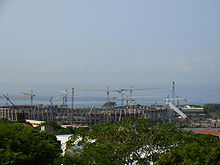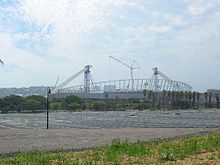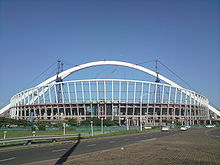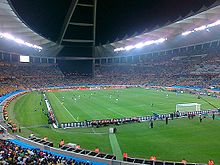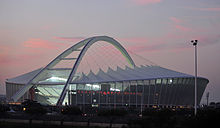- Moses Mabhida Stadium
-
Moses Mabhida Stadium 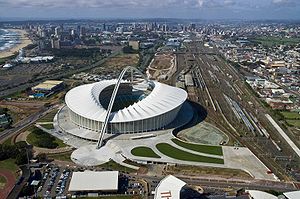
Former names Durban Stadium (During the 2010 FIFA World Cup) Location Masabalala Yengwa Ave, Stamford Hill, Durban, South Africa Coordinates 29°49′44″S 31°01′49″E / 29.829°S 31.0303°ECoordinates: 29°49′44″S 31°01′49″E / 29.829°S 31.0303°E Broke ground 2006 Opened 28 November 2009 Renovated 2009 Expanded 2009 Owner eThekwini (Durban Metropolitan UniCity) Surface Grass Construction cost R 3.4 billion
(US$ 450 million)Architect Gerkan, Marg and Partners Theunissen Jankowitz Durban, Ambro-Afrique Consultants, Osmond Lange Architects & Planners, NSM Designs, Mthulisi Msimang Capacity 62,760 FIFA World Cup[1]
54,000 afterwards
69,000 Cricket[2]Field dimensions Stadium: 320m x 280m x 45m, Arches: 100m Tenants AmaZulu [1] The Moses Mabhida Stadium is a stadium in Durban, South Africa, named after Moses Mabhida, a former General Secretary of the South African Communist Party. It is a multi-use stadium.
It was one of the host stadiums for the 2010 FIFA World Cup. The stadium has a capacity of 62,760[1] during the World Cup and 54,000 afterwards. The stadium is adjacent to the Kings Park Stadium, in the Kings Park Sporting Precinct, and the Durban street circuit used for the A1GP World Cup of Motorsport.
It includes an adjoining indoor arena, football museum, sports institute, and a transmodal transport station.
Contents
Stadium specifics
This newly built stadium is located on the grounds of the Kings Park Soccer Stadium, in the Durban sports precinct in the suburb of Stamford Hill. The stadium had the capacity to hold 62,760[1] spectators during the 2010 FIFA World Cup. Its design allows the stadium seating to be adjusted; 54,000 for local matches or up to 80,000 for events such as the Olympic Games. It has two permanent tiers of seating, a temporary third one has been added for the World Cup.
There are 150 corporate hospitality suites with 7,500 seats.
Dimensions
Stadium: 320m x 280m x 45m[citation needed]
Arch
Somewhat reminiscent of the famous Wembley Stadium arch, a 350-metre (1,148 ft) long free and 105-metre (344 ft) high span arch holds up the roof of the stadium, the top of the arch rises to 106 metres (348 ft) above the pitch. The arch also represents the once divided nation coming together, inspired by the South African Flag.[3] The arch consists of a 5 x 5m steel hollow box and weighs 2,600 tonnes. A funicular carries visitors from the north side of the stadium to a viewing platform at the top of the arch, offering a view over city and ocean. The south side features a 550-step adventure walk.[4] On 24 February 2010 the world's largest swing opened at the stadium. The swing allows clients to jump off the 4th ladder rung and fall toward the pitch before being swung out in a 220-metre (720 ft) arc over the pitch.
Roof
Moses Mabhida Stadium roof consists of a 46,000 m2 (500,000 sq ft), Teflon-coated, glass-fibre membrane which will produce a translucent glow when the stadium is lit. These are attached to the arch by 95mm diameter steel cables. The roof covers 88% of the seats.
Bowl
Around the perimeter, 1,750 columns and 216 raking beams provides the main support. Around the field, 900m of retaining walls stretches 8m high. A total of 1,780 pre-cast concrete seating panels creates the bowl form. There will be over 80,000 square metres (860,000 sq ft) of floor space within the stadium structure.[citation needed].
Facade
Over 100 columns surround the stadium. The height of the columns varies around the stadium, but the highest is 46m. In total 15,000 square metres (160,000 sq ft) of façade will surround the stadium. A total of 550 aluminum fins will fit between the main columns. Perforated metal sheeting will be placed between the aluminum fins, where required.[citation needed]
Construction progress
Date Phase Description Status 2006-07-08 1 Demolition of existing stadium, southern pavilion. Completed 2006-07-12 2 Demolition of existing stadium, northern pavilion. Completed 2006-07-23 3 Demolition of existing stadium, main pavilion. Completed 2007-04-01 4 Construction begins. Completed 2008-03-20 5 Arch construction begins. Completed 2009-01-13 5 Arch construction complete. Completed 2009-01-01 6 Aluminum façade construction begins. Completed 2009-08-01 7 Roof cable and membrane works begins. Completed 2009-11-24 Official completion. Completed Completion
Construction of the stadium was officially completed on 24 November 2009 [5] and the first official match played there was between Amazulu and Maritzburg United on 29 November, with Maritzburg United winning 1–0.[6]
2010 FIFA World Cup
The stadium was one of the venues for the 2010 FIFA World Cup and hosted five group games, one second round game and a semi-final match.[7] During the World Cup, the stadium was referred to as 'Durban Stadium'.
2010 World Cup Matches
Date Time (UTC+2) Team #1 Res. Team #2 Round Attendance 2010-06-13 20:30  Germany
Germany4–0  Australia
AustraliaGroup D 62,660 2010-06-16 16:00  Spain
Spain0–1  Switzerland
SwitzerlandGroup H 62,453 2010-06-19 13:30  Netherlands
Netherlands1–0  Japan
JapanGroup E 62,010 2010-06-22 20:30  Nigeria
Nigeria2–2  Korea Republic
Korea RepublicGroup B 61,874 2010-06-25 16:00  Brazil
Brazil0–0  Portugal
PortugalGroup G 62,712 2010-06-28 16:00  Netherlands
Netherlands2–1  Slovakia
SlovakiaRound of 16 61,962 2010-07-07 20:30  Germany
Germany0–1  Spain
SpainSemi-final 60,960 Local football
The stadium is the current home ground of Premier Soccer League team, AmaZulu. It also hosted the final of the 2010 MTN 8.
Cricket
The stadium hosted a Twenty20 cricket match between South Africa and India on 9 January 2011.[8] The match was played for the Krish Mackerdhuj Trophy, which India won by 21 runs. The stadium witnessed biggest ever crowd for a cricket match on the African continent, which was followed by a concert to celebrate South Africa-India ties (see below). It may open up a new opportunity for the stadium to further host cricket matches in the future.
Concerts
A live musical concert was held to celebrate the 150th anniversary of the arrival of Indians to South Africa following the T20 cricket match held on 9 January 2011. Some of the Bollywood stars included Sharukh Khan & Anil Kapoor.
Neil Diamond performed in Durban at the Moses Mabhida Stadium as part of his first ever tour across South Africa on April 5, 2011.
See also
References
- ^ a b c FIFA.com – Durban Stadium
- ^ http://www.sportal.com.au/cricket-news-display/honour-for-tendulkar-103007
- ^ FIFA (2010). "Durban Stadium – Durban". http://www.fifa.com/worldcup/destination/stadiums/stadium=5018127/index.htm. Retrieved 18 June 2010.[dead link]
- ^ "Moses Mabhida Stadium". http://www.durban.gov.za/durban/discover/2010/moses/. Retrieved 18 June 2010.[dead link]
- ^ A defining moment for Durban
- ^ Maritzburg win with ten men
- ^ "2010 Fifa World Cup SA Fixtures". Supersport.com. http://www.supersport.com/football/fixtures.aspx?id=275&db=1&y=2010&m=7. Retrieved 2010-05-18.
- ^ ICC website
External links
- City World Cup Site
- Stadium tours
- Stadium website
- http://www.bigrush.co.za
- 360 degree Virtual Tour of Moses Mabhida Stadium (6 locations)
- 360 View
- 360 View from the Top
- Kirigami model of Durban stadium
Premier Soccer League home venues in 2010–11 Ajax Cape Town Cape Town Stadium (7) • Newlands Stadium (4) • Athlone Stadium (4)AmaZulu Moses Mabhida Stadium (6) • Princess Magogo Stadium (3) • Ulundi Stadium (3) • King Zwelithini Stadium (2) • Sugar Ray Xulu Stadium (1)Bidvest Wits Bloemfontein Celtic Free State Stars Goble Park (9) • Botshabelo Stadium (5) • Peter Mokaba Stadium (1)Golden Arrows Chatsworth Stadium (14) • Moses Mabhida Stadium (1)Kaizer Chiefs FNB Stadium -Soccer City (6) • Rand Stadium (4) • Peter Mokaba Stadium (4) • Loftus Versfeld Stadium (1)Mamelodi Sundowns Lucas Moripe Stadium (13) • Peter Mokaba Stadium (1) • Loftus Versfeld Stadium (1)Maritzburg United Harry Gwala Stadium (15)Moroka Swallows Dobsonville Stadium (14) • Mbombela Stadium (1)Mpumalanga Black Aces Puma Stadium / Atlantic Stadium (12) • Mbombela Stadium (3)Orlando Pirates Orlando Stadium (13) • FNB Stadium -Soccer City (2)Platinum Stars Royal Bafokeng Stadium (11) • Moruleng Stadium (4)Santos Athlone Stadium (15)SuperSport United Lucas Moripe Stadium (10) • Loftus Versfeld Stadium (4) • Peter Mokaba Stadium (1)Vasco da Gama The parenthesis after each stadium, show how often it was picked as the teams home venue, according to the PSL website. 2010 FIFA World Cup Stadia Cape Town Stadium (Cape Town) • Ellis Park Stadium (Johannesburg) • Free State Stadium (Bloemfontein) • Loftus Versfeld Stadium (Pretoria) • Mbombela Stadium (Nelspruit) • Moses Mabhida Stadium (Durban) • Nelson Mandela Bay Stadium (Port Elizabeth) • Peter Mokaba Stadium (Polokwane) • Royal Bafokeng Stadium (Rustenburg) • Soccer City (Johannesburg)
Categories:- Association football venues in South Africa
- Cricket grounds in South Africa
- Sports venues in Durban
- 2010 FIFA World Cup stadiums
- Multi-purpose stadiums in South Africa
- Buildings and structures completed in 2009
- Event venues established in 2009
Wikimedia Foundation. 2010.

